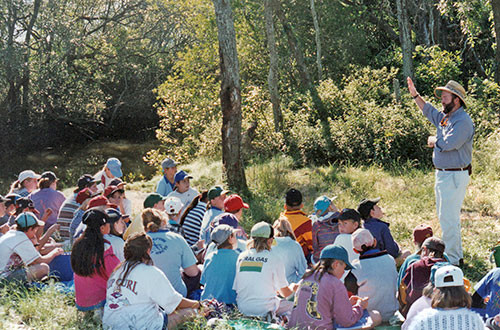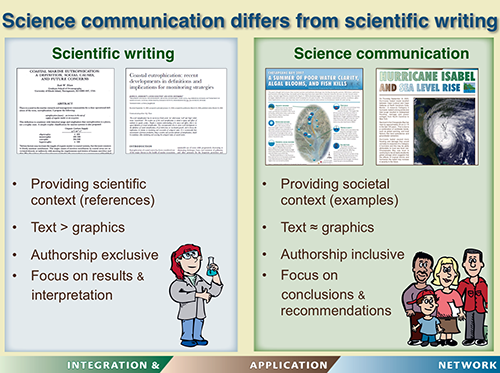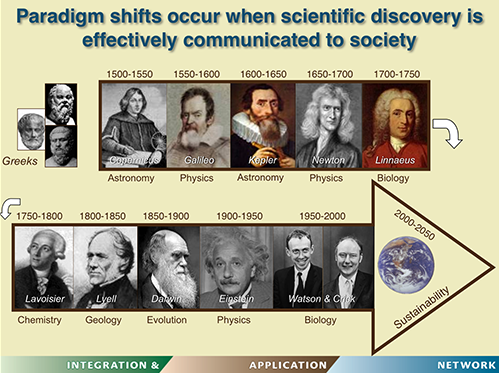Recommendations for effectively communicating science: Part 1
Bill Dennison ·This blog is the first part to a two-part series of ten recommendations for effectively communicating science. Listed are five recommendations to effectively communicate science to your audience.
Recommendation 1. Communicate science unto others as you would have them communicate unto you
Probably everyone who has attended school has been subjected to some really BAD science teaching. Modern movies and television programs often cast a nerdy science teacher droning on in a monotone voice about a science topic with little relevance to the bored students. In our personal experiences, we have been subjected to both the best and the worst science teaching. Bill started his university program majoring in biology, but after several really bad teachers, searched around for alternatives until a fortunate set of circumstances landed him in a class with a gifted science educator. Single teachers can and always will be key to the career paths of students.
Science is typically taught as a body of knowledge, with facts, laws and theories. Science teaching typically involves memorization of lots of names regarding the subject at hand. In addition, science is taught in a series of course subjects in a prescriptive order with various prerequisites that do not often appear relevant to the students. Thus, there is a considerable initiation cost before students are allowed to experience the joy of discovery that underlies the scientific approach. Because of the educational system failure to deliver science to all but the most persistent students, the public perception of science and scientists is generally not positive. Yet, we are in an age when science literacy is crucial for major societal decisions. For example, the climate change debate – pitting a well-considered scientific consensus versus a few climate change deniers has become a political driven debate, with the science taking a back seat.

Recommendation 2. Take direct responsibility to effectively communicate science: Don't rely on intermediaries.
One of our central tenets is that scientists need to take direct responsibility for effective communication. Rather than rely on intermediaries like journalists or media people, and even science journalists, we feel that it is the responsibility of the scientific community to communicate well. Good science journalists can and do produce magnificent works, but they are increasingly rare. The basic questions that scientists ask should be clear and relatively straightforward. These clear questions should also have fairly direct answers. What is quite complicated and difficult to understand to people outside the field of specialty is the technology used to address these questions. The physical tools that scientists use can be very sophisticated, from telescopes to particle accelerators to DNA sequencers, and the analytical tools like neural networks, statistics and computational models equally sophisticated. Yet, the questions and answers are what really count in science communication, not the technology used to address the questions. It is incumbent on the scientists to communicate those simple questions being addressed and provide relatively simple answers to these questions, without invoking the sophisticated techniques used to achieve those answers.
Much of our motivation in the realm of environmental conservation has been to explore better science communication models using song, theatre and visual graphics to create a more informed citizenry – from fishermen to mayors. The Healthy Waterways Campaign that both of us contributed to was a large-scale experiment in science communication. We produced sound bites, newsletters, books, PowerPoint presentations, web materials, and environmental report cards; as well as conducted workshops, led field trips, wrote songs, and did media interviews over the course of many years in an effort to communicate science to people living in Southeast Queensland. Independently, Bill created a group of Science Communicators and Science Integrators at the University of Maryland Center for Environmental Science, who partner with federal agencies (e.g., US National Park Service) and non-government organizations (e.g., Secretariat of the Pacific Regional Environmental Programme), to create and develop science communication products and programs. Peter developed an environmental educational program with the International WaterCentre (IWC) that serves to train and educate environmental leaders from around the world.
Recommendation 3. Distinguish science communication to broad audiences vs. scientific papers to peer colleagues
Scientific writing is highly stylized, with care given to wordings that minimize ambiguity. The attempt in science writing is to be precise about what is being said and to distinguish facts (data) from inference from those facts. The referencing of scientific literature is designed to allow the reader to drill back to the original sources of each element of the intellectual foundation of the thesis being presented. The peer review system was created to insure that the facts presented are sound, the inference drawn from the facts are appropriate and the references to the literature accurate. Science writing is also regimented into sections, typically abstract, introduction, methods, results, discussion and references. The overall length is constrained and attempts to invoke creative writing techniques rejected by the editors and reviewers. All of these constraints on writing style were created to provide a fair and accurate portrayal of scientific findings. But these constraints also serve to make scientific writing inaccessible to outsiders and reduce the ability of scientists to communicate to wider audiences. The adage that an average scientific paper's title is read by 1000 people, the abstract by 100 people and the paper by 10 people provides an indication of the select audience of these papers.
Science communication to an audience beyond the scientific peer group is something that Peter and Bill have attempted throughout their careers. We have defined science communication as 'the successful dissemination of knowledge with a wide range of audiences including non-scientists'. Bill has developed a cadre of Science Communicators who work at the interface of science and art. These talented people develop colorful, information-rich print and electronic materials in which scientific data, concepts and theories are made accessible to school children, elected officials, fellow scientists and interested people. Partnering with scientists from federal agencies (e.g., U.S. National Park Service), state agencies (e.g., Queensland Department of Premier and Cabinet), large non-government organizations (e.g., Conservation International), small non-government organizations (e.g., Midshore Riverkeeper Conservancy), the Science Communicators source, access and crop illustrative photographs, construct clear and information rich maps, create conceptual diagrams in which relationships and processes are illustrated, and provide graphs and tables of data which use the essential information needed to convey meaningful information. The process of weaving these visual elements into a story combined with text in which all terms were defined, wording carefully chosen to promote understanding by non-specialists is the work of Science Integrators. This is another group of talented people who facilitate the creation of a 'storyboard', in which the scientific data providers are paired with Science Communicators to develop a mock-up of the final product, page by page, section by section. The Science Integrators then work with Science Communicators to produce initial drafts and various edits of the storyboard material, ultimately producing a high quality product with multiple authors in an intensely collaborative process.

Recommendation 4. Attempt to broaden the reach of science communication rather than narrow the focus
The first question that the professional media specialist will ask is “Who is your audience?” This question then leads to a focused and targeted media campaign aimed at this target audience. When Bill moved from his active role in the Healthy Waterways Campaign in Southeast Queensland to the Chesapeake Bay region, he was constantly asked this question of “Who is your audience?” He reflected on the fact that he had not once been asked or addressed this question in the Healthy Waterways Campaign. Yet, major policy changes were enacted and the direction of environmental degradation reversed. What that question implies is that there will be a target audience and a non-target audience. By focusing on a particular segment of the population, there will be other segments that are not addressed. Targeting is great if you want to sell soap or some other commodity, or to get someone to vote a particular way on a given date. But environmental campaigns are for the long haul – no single vote or purchase will be enough to sustain the behavior changes that are advocated in an environmental campaign. In addition, the amount of marketing money spent to convince people to choose one product over another or vote for a certain candidate far dwarfs the relatively small amount of funding typically available for an environmental campaign. Commodity marketing and political campaigns may be able to afford to segment the population and deliver tailored messages to various demographics, but environmental campaigns rarely have that luxury.
One approach that we have used to provide some degree of targeting is to develop a broad consistent message, often known as branding, which is delivered at every opportunity. This broad message is followed by a more targeted message aimed at a more specific audience (e.g., what this means to you). For example, in the Healthy Waterways Campaign, the broad message was the first element of a presentation, but then the next component was targeted either geographically or topically, depending on the audience. It was often important for everyone to see what the other segments of the population were doing. There are a couple of reasons for this; 1) there is an inevitable finger pointing if people felt that another group contributed to their environmental problems and 2) people would join into an effort if they perceived that everyone else was already involved.
The different modes of education a) formal (e.g., classroom), b) informal (e.g., museums) and c) public (e.g., media) provide different opportunities to communicate environmental or scientific topics. Each educational mode offers opportunities for creativity in their delivery. Good visualizations and real world examples will enhance the teaching effectiveness. While some people often argue that we should only focus on children because they will become the decision makers of the future, we feel as though this is just another targeting method that reduces the efforts we take to convince current decision makers. Also, focusing on children often takes us into the classroom setting that does not facilitate the engagement of children in nature. It is those experiences in nature that can build an environmental ethic with an emotional attachment to nature.
The current generation of children are 'digital natives' who have an affinity for electronic devices. Digital natives access information in very different ways compared to their parents and grandparents. Thus the mode of delivery to this generation needs to match their learning modes. If they receive their news via YouTube, Facebook, Twitter, Instagram, etc. rather than newspapers, magazines and television, then the environmental issues need to be presented in ways that digital natives will access them.
Recommendation 5. Appreciate the power of effective science communication
Bill has written about the history of science communication using examples of iconic scientists who effectively communicated their ideas to a global audience, thus fundamentally changing the way people think. These iconic science communicators were identified in half century increments: Nicholas Copernicus (1500-1550) with his revolutionary idea that the describing earth revolved around the sun, Galileo Galilei (1550-1600) developing the law of gravity, Johannes Kepler (1600-1650) articulating the elliptical movement of planets around the sun, Carlos Linnaeus (1650-1700) creating a nomenclature for naming plants and animals, Anton Lavoisier (1700-1750) creating the field of chemistry, Isaac Newton (1750-1800) describing the laws of thermodynamics, Charles Lyell (1800-1850) interpreting the geological history of the earth, Charles Darwin (1850-1900) describing natural selection and evoking evolution, Albert Einstein (1900-1950) developing the theory of relativity, Francis Crick and James Watson (1950-2000) discovery of the structure of DNA. Each of these iconic science communicators addressed a fundamental societal question: Where are we in the universe? Where did we come from? What are we made of? The next pressing societal question that needs to be addressed is the following: Can we sustain human life on this planet?
This pressing question of future sustainability on planet earth underpins the quest that Peter and Bill have been making throughout their careers. Developing sustainable solutions to the environmental issues created by evermore people consuming evermore resources provides a grand challenge. A practical thoughtful environmental philosophy is needed to guide this quest, which at times feels quixotic considering the enormity of the problems. However, the revolutions of thought created throughout history illustrate how major changes in perception can occur when effectively communicated to society. These changes in perception create 'thought revolutions', just like the Copernican Revolution changed the way people thought about the earth and the sun, and a sustainability revolution can lead to effective solutions to pollution, climate change and habitat destruction. This provides us with an underlying optimism about the future and motivates us to continue our search for effective ways to educate and communicate our environmental philosophy.

This blog post is an excerpt from Dancing with Dugongs: Having fun and developing a practical philosophy for environmental teaching and research by Peter E. Oliver and William C. Dennison, which will be released at the 2013 Riversymposium in Brisbane, Australia.
About the author
Bill Dennison

Dr. Bill Dennison is a Professor of Marine Science and Interim President at the University of Maryland Center for Environmental Science (UMCES).
Next Post > Awakening Environmental Passion
Comments
-
Abhay Kothari 11 years ago
I am involved in communicating Science in rural India and found your recommenadations very near to our practice.We have achieved great results in scientific tempre through effective science communication methods,one great example is Total Solar Eclipse of 1985,people were afraid to witness this great event due to superstition.In 1995,98 we designed the campaing with many government and NGOs and broke the myth.Millions of people witness the event with safety.
Please update me with new information.Your blog really inpiring.Conratulation for sharing your knowladge.